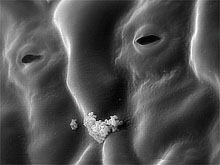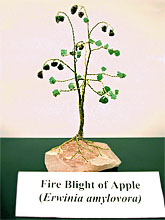Marie A. C. Langham,
South Dakota State University
The gift of an artist is to find beauty in all things, even plant pathogens. Promoting the artistry of plant pathology is the goal of Art in Phytopathology, an exhibit sponsored by the Graduate Student Committee of the American Phytopathological Society (APS) at its national meeting. The exhibit features artistic media including line drawings (black & white or color); photographs (black & white or color, digital or print); micrographs (black & white or color, electro-micrographs); mounted, dried specimens; computer animation or video; sculptures or paintings; hand-made items; and other forms of media that are relevant to phytopathology. Art in Phytopathology was first presented in 2002 and has continued as an annual event. Although artistic contributions are welcomed from all members, participation by graduate students is particularly encouraged. Prizes are awarded to graduate student presentations for “Best of Show,” “Best Creativity,” “Best Use of Medium,” and “Best Illustration of a Scientific Concept.”
Over 40 works of art were displayed this year. The art varied from precise scientific illustrations or photographs of pathogens or diseases to creative and abstract representations of plant disease. Among the outstanding presentations were works such as: “Thinker,” a scanning electron micrograph with an artistic eye for the stomata in a Theobroma cacao leaf by Aruna Kilaru from the University of Louisiana- Lafayette (Figure 1), a baby blanket with blocks representing early leaf spot and Tomato spotted wilt virus on peanut made by Sara Gremillion and Emily Catonwine from the University of Georgia (Figure 2), and an apple tree with fire blight made from copper wire and gem stones by Jane Davey from the University of Delaware (Figure 3). These items demonstrate the range and depth of the creative ability displayed at the meeting and that creativity can be found even in subjects not traditionally considered to be artistic. Plant pathologists are often thought to view plant diseases in a different light than other people, because many people don’t find creativity or artistry in leaf spots, root rots, or blights. Art in Plant Pathology is truly a case of beauty being in the eye of the beholder.

Figure 1 |

Figure 2 |
|

Figure 3 |
For more information on Art in Plant Pathology, try the November 2004 APS feature article, Art in Plant Pathology.
In some cases, plant diseases add beauty or value to a plant. For examples of these, try The Flowering Maple And Its Virus by Dr. T. Ombrello or Tulip Breaking or Mosaic, a publication by the University of Illinois Extension.
Linking Science and ArtWhat Does Plant Disease Look Like?
After discussing plant disease, encourage your students to make drawings, artistic representations, or photographs of plant disease. Those that are sent to me will be displayed at the APS Education Center Editors meeting during the APS national meeting in August. We will be interested to see your students’ interpretation of plant disease and its effects on plants. My address is:
Marie A. C. Langham
South Dakota State University
Plant Science Department
Plant Science Building
PO 2108
Brookings, SD 57007
marie.langham@sdsu.edu
Please include an address in case we would need to contact you. However, art projects that are sent in will not be returned after the APS meeting. |
 |
Views: Recent outbreaks of citrus canker in lime groves in the Miami, Florida area have been reported by the news media. Although the disease is not a health threat to humans, it is of great concern to the citrus industry. Click here for more information.
|
